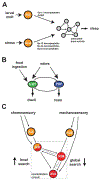Dynamic functional connectivity in the static connectome of Caenorhabditis elegans
- PMID: 35183877
- PMCID: PMC9621599
- DOI: 10.1016/j.conb.2021.12.002
Dynamic functional connectivity in the static connectome of Caenorhabditis elegans
Abstract
A hallmark of adaptive behavior is the ability to flexibly respond to sensory cues. To understand how neural circuits implement this flexibility, it is critical to resolve how a static anatomical connectome can be modulated such that functional connectivity in the network can be dynamically regulated. Here, we review recent work in the roundworm Caenorhabditis elegans on this topic. EM studies have mapped anatomical connectomes of many C. elegans animals, highlighting the level of stereotypy in the anatomical network. Brain-wide calcium imaging and studies of specified neural circuits have uncovered striking flexibility in the functional coupling of neurons. The coupling between neurons is controlled by neuromodulators that act over long timescales. This gives rise to persistent behavioral states that animals switch between, allowing them to generate adaptive behavioral responses across environmental conditions. Thus, the dynamic coupling of neurons enables multiple behavioral states to be encoded in a physically stereotyped connectome.
Copyright © 2021 The Author(s). Published by Elsevier Ltd.. All rights reserved.
Conflict of interest statement
Conflict of interest statement Nothing declared.
Figures



References
-
- Moore T & Zirnsak M Neural Mechanisms of Selective Visual Attention. Annu. Rev. Psychol 68, 47–72 (2017). - PubMed
Publication types
MeSH terms
Substances
Grants and funding
LinkOut - more resources
Full Text Sources

